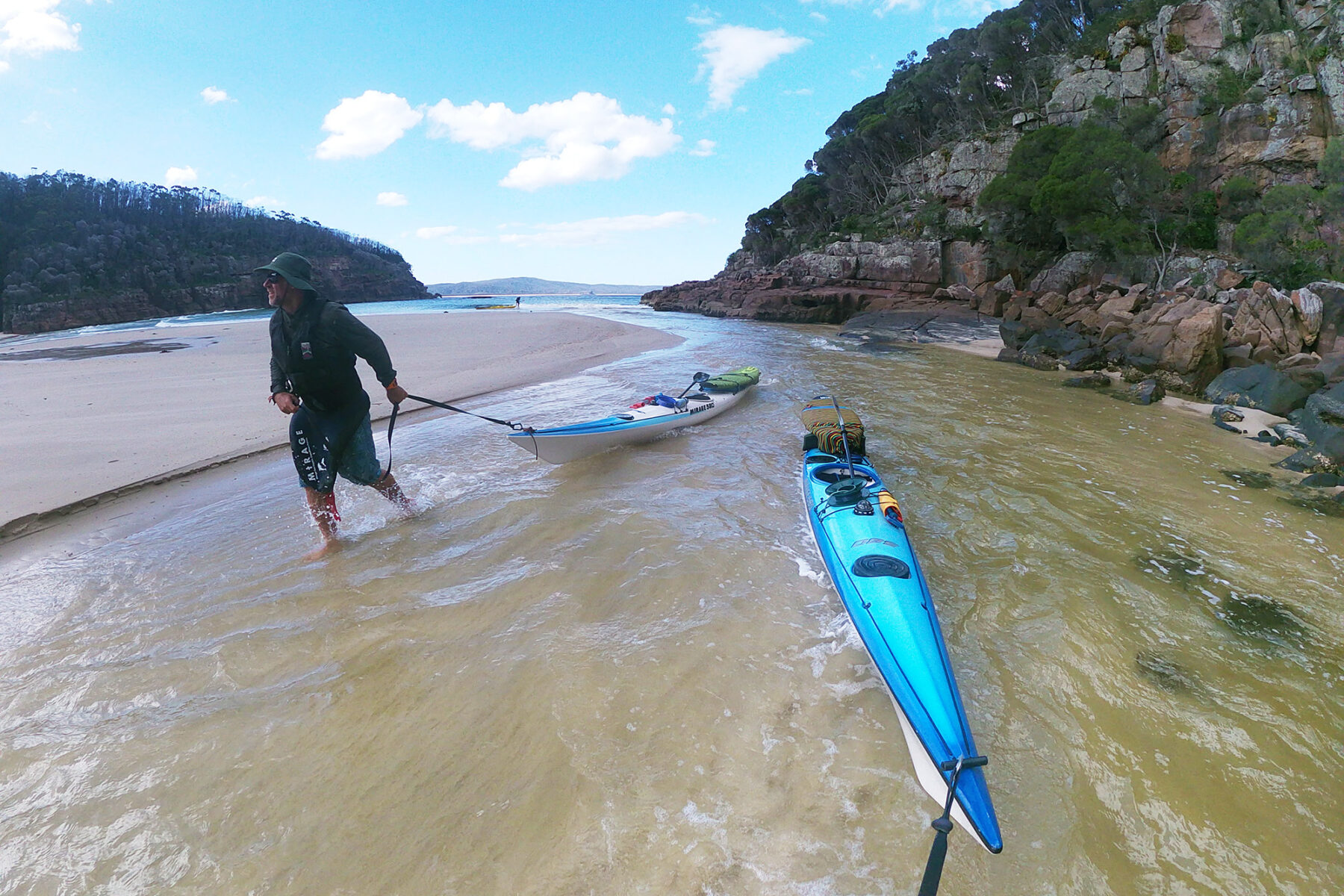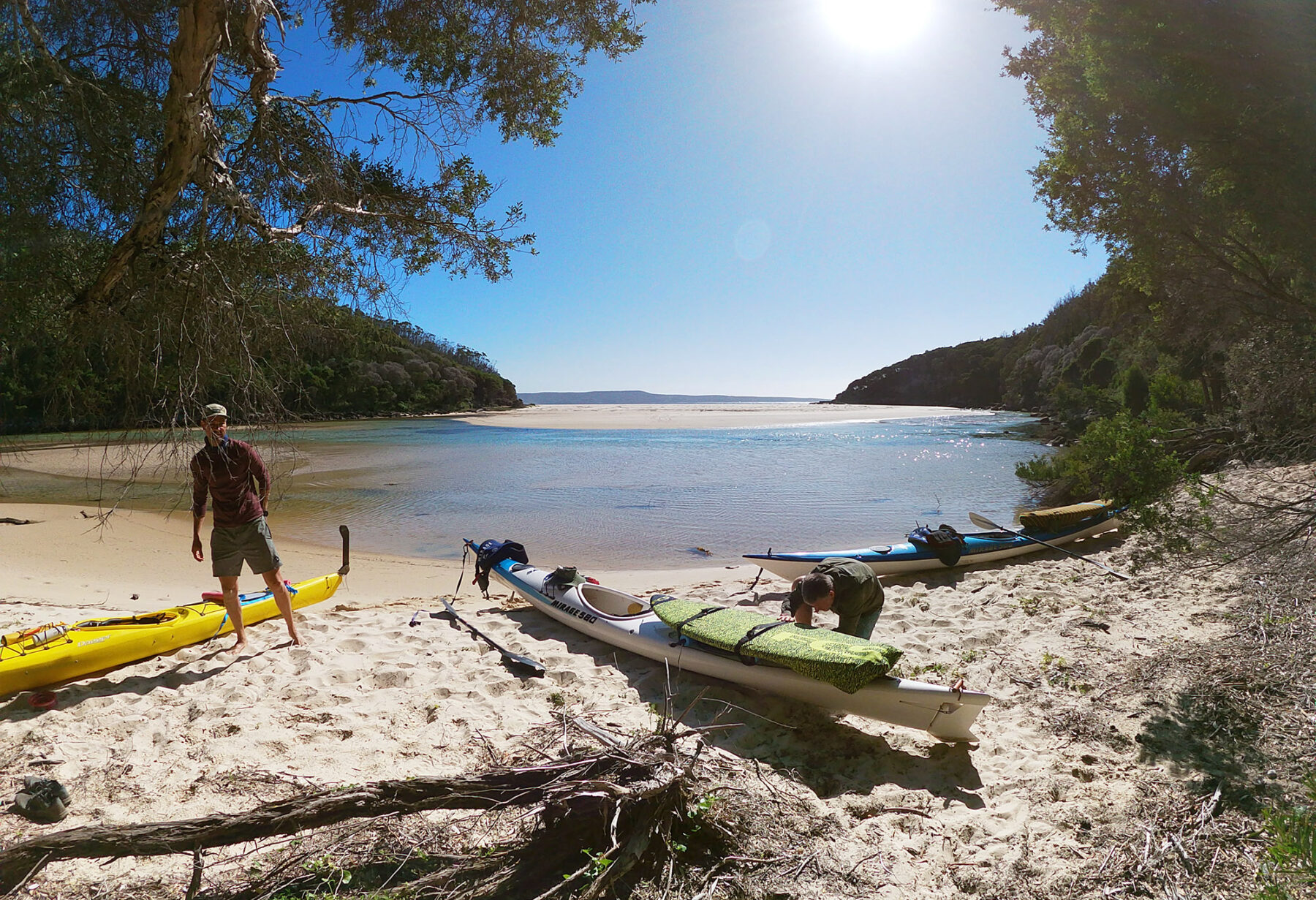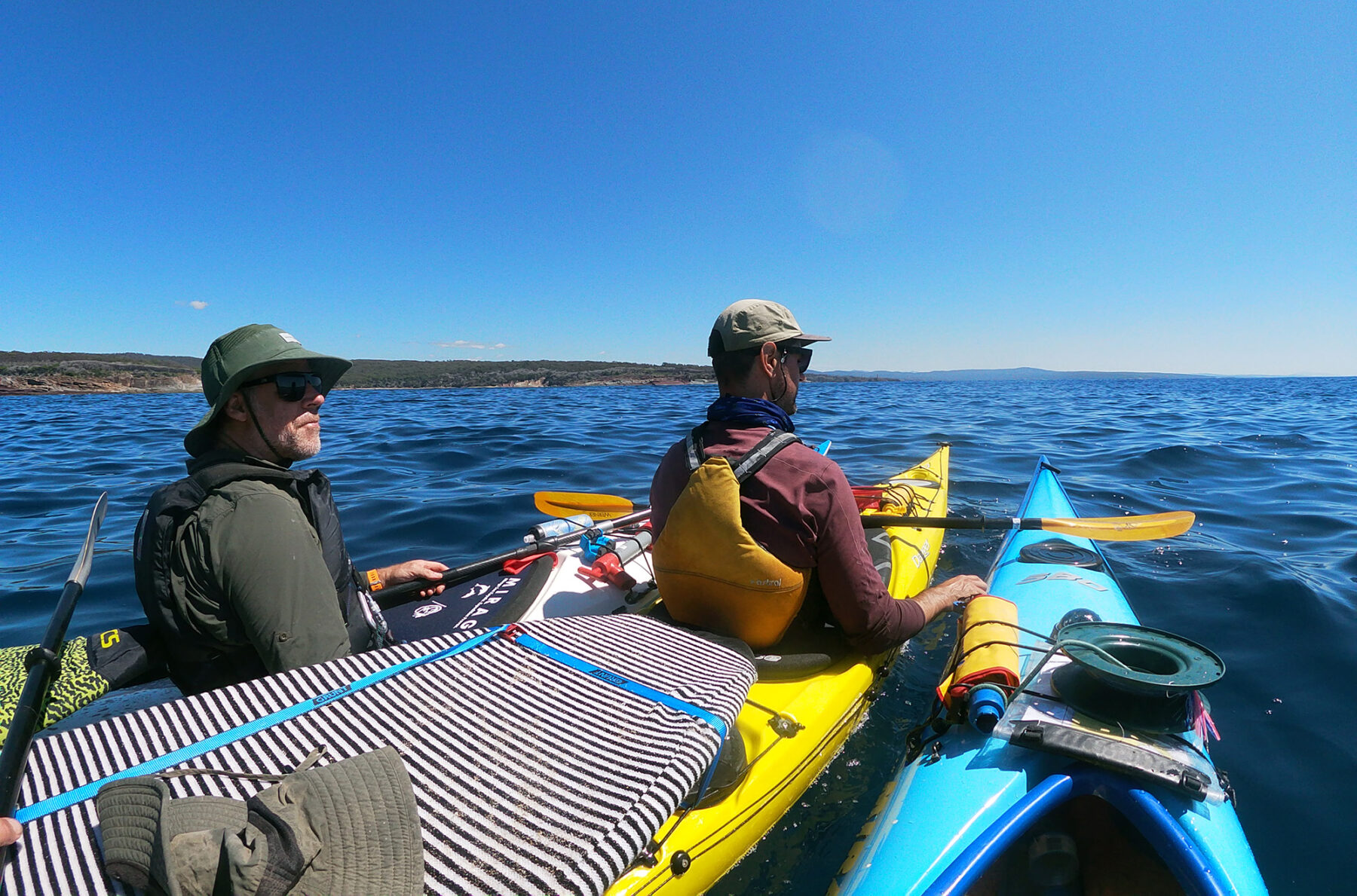I’m a dreamer. A slight lapse in concentration, and I’m thinking about new adventures. Map gazing is oxygen to the fire and the south-east corner of Australia always draws my eye. Google Maps quickly revealed long, remote sections of coast. What’s out there? What’s the best way to access these areas? There must be secret surf breaks. On short notice, our group of three, with the WhatsApp handle of ‘Castaway’, agreed to a backyard kayaking adventure.
Traversing this terrain in sea kayaks sounded hard to beat. Jump in at Mallacoota, Victoria, and pull out in Merimbula, on the NSW Sapphire Coast, 120km later. This wasn’t just going to be an adventure, but a holiday as well. No pre-dawn starts, no rushing, plenty of coffee brews, leisurely days and hopefully no mobile reception. With our sea kayaks having at least 180 litres storage volume, there would be plenty of space for luxuries, too (and it would be luxury: compared to a large backpack at 80 litres volume – our go-to for load-lugging on our land-borne trekking adventures – we’d have additional space for all sorts of gear). Some final preparation – including some hillbilly ingenuity where Patto had solved the problem of carting the surfboards – and we’d be underway. The search was on!
On waters unknown
Underestimating the faff factor delayed departure on day one at Mallacoota. The checking of gear and organising it in some logical way into dry bags before packing and repacking these odd shapes into the front and rear hatches burned through time. Where did that 180 litres of storage disappear to? Not being too sure of fresh water supplies, each paddler also carried at least 15 litres of water onboard. On land, these loaded up vessels are beasts and hard to move. But once launched, they bob lightly and with a 5-knot south-westerly on our rear quarter, they loved the forward momentum, covering the 13km to Gabo Island effortlessly.

The only place to land at Gabo Island is a small, protected beach on the western side. Unfortunately, camping on the island is not permitted. Ideally, you would make an early start from Mallacoota to allow for a few hours of exploring the island before moving on. Alternatively, you could stay in the assistant light keeper’s residence but it’s a minimum two-night stay. Due to our less than perfect start that day, we were compromised. Rather than put to sea on a setting sun, our safest option was to bed down and beg forgiveness.

In the morning we hiked over to south of the island to make good with Parks and behold the exquisitely constructed 159-year-old pink granite lighthouse. A quick snorkel before departing revealed an underwater garden rich in sea life and well worth the cold Victorian water.
The mythical land becomes real
Our first trial was day two from Gabo Island to Cape Howe. BOM [Bureau of Meteorology] records show testy conditions with winds picking up to 57 km/h from the SW, gusting up to 81 km/h. After rounding the northern spit of Gabo and threading the choppy gap with Telegraph Point on the mainland, we pointed south-west and held onto the dragon’s back. The ride was fast, getting to the point of exhilarating, with the building wind and swell. It also wasn’t a bad time to review our kayaking safety plan: stay close to each other, anyone goes over, we raft up and regather. As the nautical miles sailed by, my mates’ skills and confidence grew.

Rounding Cape Howe to a secluded beach brought respite and relief. After nesting into a delightfully protected campsite at the southern end of the beach, we hit the beach break for a fun little surf. Around the fire that night, lips were loosened with a few craft beers and wee drams of whiskey, and the day remembered. “Lots of self-talk going on; I was just telling myself to keep it together!” Patto revealed. Wojo murmured something about white knuckles. We were energised. The remoteness was special. The only sign of other humans was a single set of footprints in the sand. (For more secret paddling locations around the world, see here.)
The prevailing winds would stay south-westerly for the whole trip, which was ideal for our kayaking journey. Paddling north for the next four days and 100km meant we were fairly well protected, with just a hint of tailwind assistance. Over those four days, the holiday vibe kicked in, judging by the numerous brekkie coffee brews and the 11am departure. The 5.5-hour, 27km paddle to Merica River was relaxing and largely uneventful until we rounded the bluffs guarding Disaster Bay. Here, the water erupted with sea life. The food chain was on full display, with bait-fish being rounded up by bigger predators while terns and gulls bombed from the sky. Seals and dolphins were in on the feed, too. Then we saw something that was bigger than a regular dolphin but on the small side of a whale. We had no idea what we were seeing. My Googling suggests it was possibly a Risso’s dolphin, the largest of the dolphin species, but we’re still not sure. Regardless, we had the perfect front row seats to witness the rawness and beauty of nature.
A reason not to rush
Our primary navigation tools were old school – a paper marine chart (Cape Howe to Montague Island) and deck-mounted compass. Carefully folded to the day’s section and stowed in a waterproof map case, it was a constant reference through the day. Marine charts are not rich with topographical data, which can mean a few surprises when striking land. Merica River doesn’t even feature on the chart except as a little beach flanked by cliffs, so the sense of discovery when we dragged our boats 200m upstream to a plush, protected campsite was pure joy.


Breakfast burritos with rounds of Aeropress set us up for our usual late morning departure from our pristine Merica River campsite on day four. With the whiskey running low, I was super-keen to replenish our luxuries in Womboyn, but a decent beach break persuaded us otherwise. We pushed on towards Green Cape, which marks the start of Beowa National Park, spanning 47km of coastline all the way to Merimbula. Rounding the cape brought an immediate and stunning change to the landscape, with the rocks folded and layered in rich ochre reds, browns and whites. The kayaking was peaceful as we hugged the serrations of these low, ancient cliffs for 7km to lunch and fresh water supplies at Bittangabee Creek. The perfection of Bittangabee Bay made it hard to leave, but the hint of wave at Saltwater Creek encouraged us to get moving.
Landing at the northern end of Saltwater Creek provided some unexpected entertainment. Wojo latched onto one of the bigger waves and was cutting it like a pro. Perhaps there was some hooting. The wave crescendoed on a shallow bank before its surfer could pull off the back. Carnage. Followed by a yard sale. That night we feasted on abalone and laughter. Things weren’t perfect – perfect would be a cranking point break – but they were pretty damn fine.

The fifth day of kayaking saw us at Eden, nestled beside magical Twofold Bay, for lunch. An Aussie burger with the lot nearly hit the spot – a schooner got us all the way there. Loaded up with fresh steak, veges and cold beer we left Eden, heading north out of Twofold Bay, with an escort of around thirty dolphins. The close and extended interaction with these wild animals was exhilarating. A couple of hours later we eased into Terrace Beach for our final night under stars. Chilli corn, baked potatoes and steak cooked on a coal fire washed down with cold craft beers? It was too good to be true.
In the real world
During this kayaking journey, I dug my phone out once, in Eden, to assure loved ones that we were making progress. The digital detox was real; I felt lighter, less encumbered, more present. The great holiday reading plans were reduced to a page or two a night before the eyelids shuttered; I was tired but energised. The outdoors connect me; zoom me in, zoom me out, offer perspective and sometimes reason. As we paddled the final few hours into Merimbula on day six, I vowed to take the good things; the insights, the truths, and keep them present. The far south coast – the forgotten coast – is a jewel. Next time, I will take more time.



